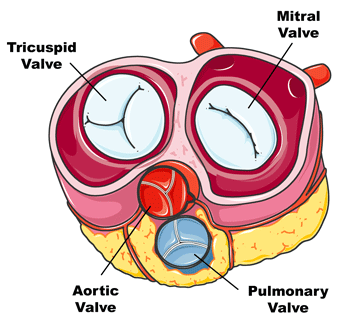Mitral Valve Murmurs
Written By: Adam Pick, Patient Advocate, Author & Website Founder
Medical Expert: Junaid Khan, MD, Sutter Health
Page Last Updated: May 14, 2025
Before we discuss mitral valve murmurs, I thought it might help you to spend just a little bit of time talking about the anatomy of the heart and the mitral valve.
If you did not know, the mitral valve is located in the heart between the left ventricle and the left atrium, two of the heart's four chambers. When blood, returning from the lungs where it has been oxygenated, fills the left atrium, the mitral valve opens to allow the blood to flow into the left ventricle.
The valve functions as a type of door to regulate the rate and quantity of blood that passes, closing when the left ventricle fills.

What Is A Mitral Valve Murmur?
If the mitral valve is not opening widely enough or does not seal properly when it is supposed to be closed, a physician may detect an unusual sound through a stethoscope. This is because the abnormal blood flow can produce a turbulence as it moves in an non-syncopated manner. The physician may refer to this as a mitral valve murmur or heart murmur.
To educate our patient community about heart murmurs, I filmed this video with Dr. Junaid Khan, a leading heart surgeon from Alta Bates Medical Center in Oakland, California. It's very interesting to hear how Dr. Khan compares a heart murmur to water flowing down a river with rocks and rapids.
The heart goes through two phases as it beats. In the first phase, the atrium fills with blood, then a contraction forces blood into the ventricle. This is known as systole. Once the ventricle has filled, the mitral valve closes and a contraction pumps blood from the ventricle. The diastole phase is the period when the chambers are filling with blood or relaxing. If the ventricle is relaxing, it is known as ventricular diastole. If the atrium is relaxing, it is known as atrial diastole.
The physician can tell a great deal about a heart murmur by listening to it. Certain murmurs occur at different times during the heartbeat, which can often indicate the cause of the murmur. For example, in a patient with mitral valve stenosis, the murmur normally occurs during the diastolic phase. Mitral valve regurgitation, on the other hand, is typically present during the systolic phase.
About Mitral Valve Prolapse & Regurgitation
A heart murmur that is most pronounced when the stethoscope is positioned at the heart's apex and occurs in the late systolic phase may be caused by mitral valve prolapse. This is also known as floppy valve syndrome. The murmur is normally preceded by a series of clicks. With a severe prolapse, blood may flow back into the atrium, a condition known as mitral regurgitation. (So you know, leaking aortic valve disease is commonly referred to as aortic regurgitation.)
To hear a mitral valve murmur with regurgitation sound, pleae click the link below:
The physician may ask the patient to perform a series of maneuvers to help with the diagnosis. Activities such as sitting or standing that decrease the volume in the left ventricle can make the murmur last longer or decrease its intensity. Such maneuvers may also encourage the clicks to begin sooner. Maneuvers that increase the volume in the left ventricle, such as elevating the legs or squatting, may cause the murmur to last for a shorter period, increase its intensity, or delay the beginning of clicks.
About Mitral Valve Stenosis
With mitral stenosis, the murmur has a bit of a rumble and normally starts with a snapping sound. It typically occurs in the middle of the diastolic phase and can be more pronounced when the stethoscope is positioned over the left ventricle. As a general rule, the most severe cares of mitral stenosis produce murmurs of the longest duration. However, in patients with heart valve stenosis that has become severe enough to seriously reduce the blood flow, or in conditions such as pregnancy where output is abnormally high, the rule may not apply.
Mitral Valve Murmur Considerations
Other key points to consider about mitral valve murmurs include:
- Rarely, a patient may have a heart murmur that does not fit neatly into a category. These are often called continuous murmurs. This type of murmur is caused by blood flowing from a chamber with higher pressure into one with lower pressure.
- With mitral valve obstruction, a small atrial defect can shunt blood from left to right. This condition can increase the patient's risk of infection and pulmonary edema.
The underlying condition that causes a mitral valve murmur may be congenital, meaning the individual is born with the defect. Other conditions can result from the aging process or as a complication arising from a disease. The murmur may indicate a seriously compromised valve, but may also indicate a condition that can remain asymptomatic for many decades. However, a patient should be monitored carefully so that action can be taken if the condition worsens.
You Might Also Like
To learn more about mitral valve murmurs, here is additional educational information and patient updates that can help you:





